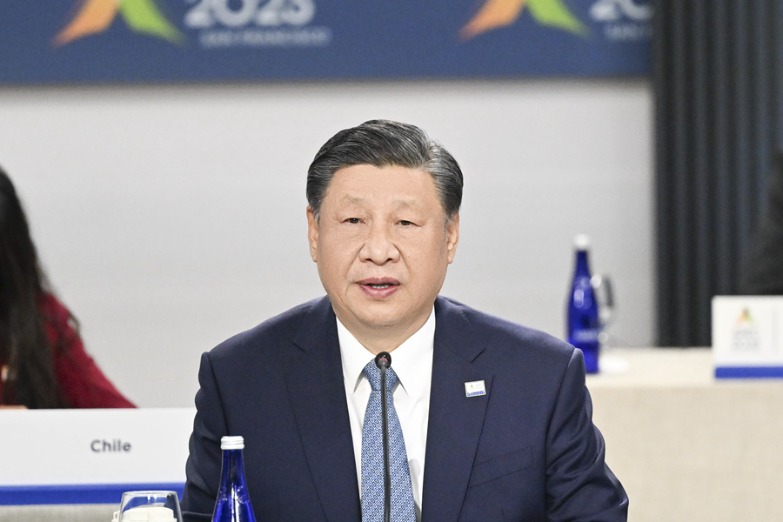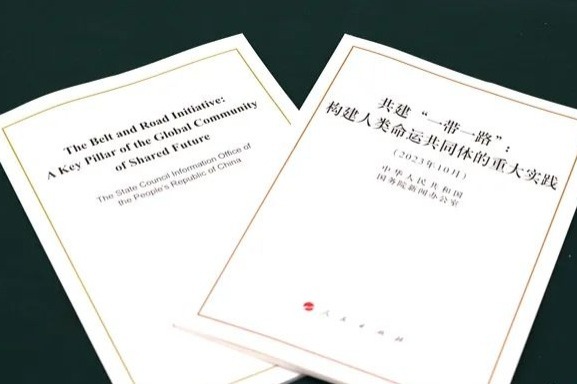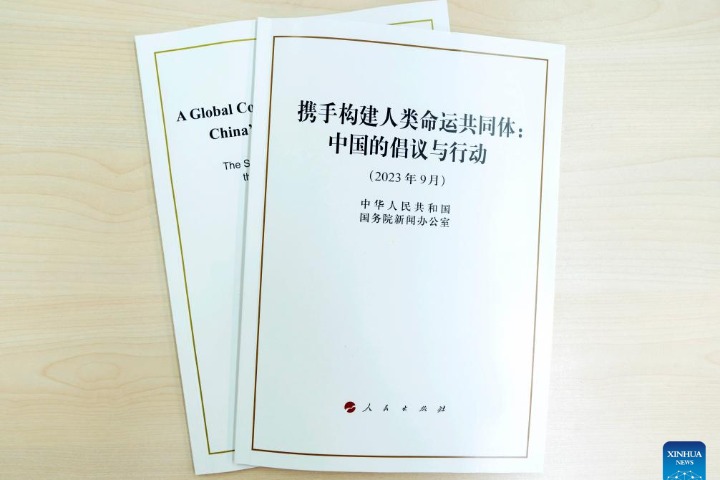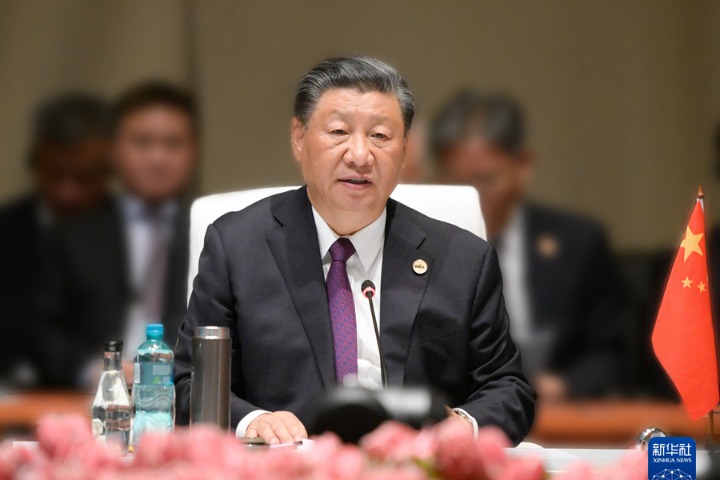《新疆的文化保护与发展》白皮书(双语全文)
新华网 2018-11-16 09:45

五、文化事业和文化产业不断发展
V. Constant Development of Cultural Undertakings and the Cultural Industry
文化发展的核心是满足人的精神文化需求。中国政府支持新疆努力提高公共文化服务水平,促进文学艺术创作和新闻出版繁荣进步,增强文化产业实力,保障公民文化权利,丰富各族人民精神文化生活。《中华人民共和国公共文化服务保障法》《中华人民共和国公共图书馆法》《中华人民共和国电影产业促进法》等法律法规为保障新疆各族人民基本文化需求,提供公共文化服务,促进文化产业发展提供了重要法治保障。
The core of cultural development is to satisfy people's cultural and intellectual needs. The Chinese government has given steady support to Xinjiang in its efforts to improve the quality of public cultural services, promote progress in literary and artistic creation and the press and publishing, strengthen the cultural industry, protect citizens' cultural rights, and enrich the cultural life of all ethnic groups. The Law of the People's Republic of China on Protection of Public Cultural Service, Law of the People's Republic of China on Public Libraries, and Law of the People's Republic of China on the Promotion of the Film Industry among others have served as important legal guarantee to protect the basic cultural needs of all ethnic groups in Xinjiang, provide them with public cultural services and promote the development of its cultural industry.
公共文化服务水平日益提高。1955年,新疆有1个公共图书馆、各类体育场地425个。在中央政府大力支持下,近年来,新疆实施“县级文化馆、图书馆修缮工程”“文化信息资源共享工程”“乡镇综合文化站工程”等一系列文化基础工程。截至2017年,新疆有公共图书馆112个、博物馆和纪念馆173个、美术馆57个、文化馆119个、文化站和文化室12158个,有各级各类广播电视台(站)302个,广播和电视人口覆盖率分别达到97.1%和97.4%,有体育场地29600个,形成了相对完整的各级公共文化服务体系。
The quality of public cultural services is improving. In 1955, there were only 425 sports venues and one public library in Xinjiang. With the massive support of the central government, successive cultural projects have been launched in Xinjiang such as "conservation and renovation project of county-level cultural centers and libraries", "cultural information sharing project" and "township cultural centers project". By the end of 2017, Xinjiang had 112 public libraries, 173 museums and memorial halls, 57 art galleries, 119 cultural centers, 12,158 cultural stations, 302 radio and television stations (covering 97.1 percent and 97.4 percent of the population, respectively), and 29,600 sports venues, representing a comparatively complete public cultural service system at all levels.
新疆积极推进城乡公共文化服务均等化。文化馆、图书馆、博物馆、乡镇(街道)文化站等公共文化设施免费向社会开放。基本实现户户通广播电视。农村电影放映实现行政村全覆盖。财政安排资金支持为贫困乡村提供戏曲等多种形式的文艺演出。广泛开展全民阅读活动,农家书屋工程覆盖所有行政村。截至2017年,共举办13届自治区运动会、8届少数民族传统体育运动会、5届老年人运动会、6届残疾人运动会。村级“农牧民体育健身工程”实现全覆盖。新颖多样的健身器材在边远乡村普及,丰富有趣的体育比赛和健身活动深受各族群众欢迎。
Xinjiang has made efforts to ensure equal access to public cultural services for both urban and rural residents. Public cultural facilities such as cultural centers, libraries, museums and cultural stations are open to the public for free. The radio and television network covers almost every household. Movie projection is available in all administrative villages. Theatrical performances of various types are given in impoverished villages with the support of government funds. A reading campaign is encouraged by ensuring full coverage of rural libraries over all administrative villages. By the end of 2017, 13 sports meetings, eight traditional ethnic minority sports meetings, five games for senior citizens and six games for disabled people had been held in Xinjiang. Fitness projects for farmers and herdsmen cover all villages. Gym equipment of all sorts is available even in remote villages. Rich and interesting sports events and fitness activities are popular with people of all ethnic groups.
文学艺术创作和新闻出版持续繁荣。新疆文学艺术佳作纷呈,生动展现了中华文化魅力。小说《天山深处的“大兵”》、诗集《神山》、散文集《在新疆》、文学评论集《西部:偏远省份的文学写作》、油画作品《来自高原的祈福——5·19国家记忆》、摄影作品《风雪人生》、话剧《大巴扎》、舞剧《阳光下的舞步》《戈壁青春》、歌舞剧《情暖天山》、音乐剧《冰山上的来客》、音乐杂技剧《你好,阿凡提》、歌曲《屯垦爹娘》、广播剧《马兰谣》和电影《大河》《鲜花》《真爱》《生死罗布泊》《塔克拉玛干的鼓声》等一批文学艺术作品获得精神文明建设“五个一工程”奖、鲁迅文学奖、中国电影华表奖等国家级奖项,杂技《生命之旅》《抖杠——担当》等获得国际杂技节金奖。2006年,成立新疆广播影视译制中心,相继在11个地、州和伊宁市、莎车县、库车县、于田县建立电视译制部。目前,少数民族语言影视剧年译制量达6200集左右。中华人民共和国成立前,新疆仅有2种报纸。截至2017年,新疆共有报纸126种,期刊223种,每年出版图书、音像制品和电子出版物约1万种。
Literary, artistic creation, press and publishing are booming. A variety of brilliant works of literature and art created in Xinjiang demonstrate the glamour of Chinese culture. The following have all won national prizes such as the Best Works Award, Lu Xun Literary Prize, China Movie Awards, and the first prize in International Acrobatic Festival:
·Soldiers from the Snow Mountain (novel),
·Holy Mountain (poetry anthology),
·In Xinjiang (collection of prose writings),
·Western China: Literary Writing in Remote Provinces (collection of literary review),
·Praying on Plateau, Chinese Mourning Day on May 19th (oil painting),
·Braving the Storm (photography),
·Grand Bazaar (drama),
·Dance Steps in the Sun and Young Blood in Gobi Desert (dance drama),
·A Uygur Mother and Visitors on the Icy Mountain (musical),
·Hello, Advanti (musical and acrobatic drama),
·My Parents Stationing and Reclaiming Wasteland in Xinjiang (song),
·A Nuclear Scientist's Story in the Desert (radio play),
·The Great River, Flower, Genuine Love, Life and Death in Lop Nor, Taklimakan's Drumbeat (movie).
·Travel of Life (acrobatic show),
·Somersault on Balance Beam (acrobatic show).
In 2006, Xinjiang Radio, Film and Television Translation and Production Center was set up, establishing branches in 11 prefectures, Yining City, Shache, Kucha and Yutian counties. Currently, about 6,200 episodes of translated ethnic film and television programs are being produced every year. There were only two newspapers in Xinjiang before the founding of the People's Republic of China. But by the end of 2017, Xinjiang had 126 newspapers, 223 periodicals, and publishes around 10,000 titles of books, audio and video products and electronic publications every year.
文化、体育和民族医药产业实力逐步增强。目前,新疆有文化企业1万余家,已形成门类较为齐全的文化产业发展体系,涵盖新闻出版发行、广播影视、演艺、文化娱乐、游戏、文化旅游、工艺美术、艺术品、动漫、文化会展、创意设计、数字文化服务等领域。截至2017年,有国家级文化产业示范基地6家,自治区级文化产业示范基地109家,获得国家认定的动漫企业11家,建成各类文化产业园区20家;有国家5A级景区12家,导游17000人。文化及旅游产业增加值逐年增长。
Strength in cultural, sports and ethnic medicine industries is growing. At present, Xinjiang has over 10,000 cultural companies covering press, publishing and distribution, radio, film and television, performances, entertainment, games, cultural tourism, arts and crafts, artwork, animation, cultural exhibitions, innovation design and digital cultural services. By the end of 2017, there were six model bases for cultural industries at national level, 109 at autonomous region level, 11 government-approved animation companies, 20 cultural industry parks, 12 national 5A tourist attractions and 17,000 tourist guides. The added value of the cultural and tourist industries is growing every year.
成立一批职业体育俱乐部,体育竞赛与表演市场日趋活跃。环塔克拉玛干汽车摩托车越野拉力赛、中国篮球职业联赛新疆区比赛保持较高市场化运作水平。以中国国际露营大会、国际沙漠越野挑战赛、环艾丁湖摩托车赛、环赛里木湖公路自行车赛等为代表的体育休闲市场日趋成熟。赛马、冰雪运动、航空体育产业发展潜力巨大。
A group of professional sports clubs have been set up, with sports competitions and sports show flourishing. The Taklimakan Rally is a commercial success and China Basketball Association (CBA) in Xinjiang is doing well. The sports leisure market is maturing as demonstrated by the success of the China International Camping Congress, International Desert Cross Rally, Aydingkol Motorcycle Rally, and Sayram Bicycle Rally. Huge potential is also apparent in horse racing, winter sports and aviation sports.
新疆已形成中华医药(含民族药)、医疗机构制剂、食品(含保健食品)、医疗器械和药用包装材料等门类较为齐全的医药健康产业体系。其中维吾尔医药、哈萨克医药、蒙医药等少数民族传统医药历史悠久,是中华文化瑰宝,许多药材被纳入国家标准和国家相关标准化研究项目。新疆民族医药销售产值占制药行业销售总产值比重逐年提高;民族医药企业的产品在不断开拓国内市场的同时,还销往周边国家和地区,进入国际市场。
Xinjiang has formed a complete industrial system of medicine and health covering Chinese medicine (including ethnic medicine), hospital-made preparations, foods (including health foods), medical equipment, and packaging for medicines. Among ethnic medicines, many Uygur medicines, Kazakh medicines, and Mongolian medicines - boasting a long history and regarded as cultural treasures - have been categorized under national standards or included in national standardization research projects. The sales of ethnic medicines in Xinjiang's pharmaceutical industry are increasing year by year, and ethnic medicine companies are expanding sales not only in domestic markets, but also in neighboring countries and regions as an effort to enter the international markets.
网络文化蓬勃发展。随着互联网在中国的不断发展,近年来,互联网越来越成为新疆各族人民学习、工作、生活的新空间,获取公共服务的新平台。截至2017年,新疆备案网站11520家,固定宽带用户达569.9万户,移动互联网用户达1855.8万户。微信公众平台“最后一公里”用户遍及全国所有省、自治区、直辖市和几十个国家、地区。先后实施争做中国好网民、艾德莱斯网络引领、网络融情等工程,开展“网络中国节”“我是一颗石榴籽”“艾德莱斯出天山”等系列网络文化活动30余项,示范带动新疆各地开展各类网络文化活动7000余项。2017年,新疆本地消费者网购零售额达569.1亿元,比上年增长29.8%。蓬勃发展的网络文化引领了向上向善的社会风尚。
Internet culture develops rapidly. The rapid development of the internet in China has made it the new space for people of all ethnic groups in Xinjiang to study, work and live, and a new platform to access public services. By the end of 2017, Xinjiang had 11,520 registered websites, 5.7 million fixed broadband subscribers, and 18.56 million mobile internet users. The subscribers on the official WeChat platform "Last Kilometer" extend across all provinces, autonomous regions, municipalities directly under the central government and dozens of countries and regions. Over 30 internet cultural projects such as "making a good netizen", "Etles Silk from Tianshan to the World" and "video programs on ethnic solidarity" launched more than 7,000 online cultural activities across Xinjiang. In 2017, online retail sales to Xinjiang consumers reached 56.91 billion yuan, an increase of 29.8 percent over 2016. The prosperity of Xinjiang's internet culture helps to foster healthy social morals.
六、对外文化交流日趋活跃
VI. Active Cultural Exchanges with Other Countries
新疆是中华文明向西开放的重要门户,在东西方文明交流互鉴中发挥了重要作用。在中央政府支持下,新疆已形成全方位、多层次的对外文化交流格局。
Xinjiang has been an important gateway for China's civilization to open to the West, and has played a significant role in cultural communication and mutual learning between East and West. Supported by the central government, Xinjiang has created a framework of cultural exchanges with other countries in all sectors and at all levels.
以多种形式参与国际文化交流与合作。中国新疆国际民族舞蹈节、中国-亚欧博览会“中外文化展示周”和“出版博览会”等成为具有一定国际影响力的文化交流品牌。2009年以来,举办了7届“中国·新疆国际青少年艺术节”,邀请中亚四国及俄罗斯、蒙古、巴基斯坦、印度、马来西亚、泰国、韩国、阿塞拜疆等12个国家及国内共119个文艺团体的2330余名青少年来新疆演出交流。2012年至2017年,新疆连续举办7期“丝绸之路经济带相关国家媒体负责人研修班”,邀请了25个国家的100多家媒体负责人来新疆研修、交流、考察。
Xinjiang participates in international cultural exchanges and cooperation in various forms. Xinjiang International Ethnic Dance Festival, Chinese and Foreign Culture Week of China-Eurasia Expo, and Publishing Expo have become branded cultural exchange projects of considerable international influence. Since 2009, Xinjiang has held seven China International Youth Arts festivals, inviting more than 2,330 young people representing 119 art troupes from Turkmenistan, Kazakhstan, Uzbekistan, and Kyrgyzstan of Central Asia and Russia, Mongolia, Pakistan, India, Malaysia, Thailand, the Republic of Korea and Azerbaijan. From 2012 to 2017, Xinjiang has held seven seminars for directors of media from countries along the Silk Road Economic Belt, inviting directors of more than 100 media from 25 countries to Xinjiang on study, communication and visits.
近年来,新疆积极推进“丝绸之路经济带”核心区建设,加强与沿线国家的人文科技交流。2016年,举办第五届中国-亚欧博览会科技合作论坛,30多个国家和国际组织的154名嘉宾受邀参加。建成12个国家级国际科技合作基地,与30多个国家和地区以及10个国际组织和研究机构开展了国际科技合作与交流,涉及农业、资源环境、农产品加工、天文、煤化工、生物医药、能源等领域。稳步实施“留学中国计划”,逐步扩大丝绸之路经济带沿线国家优秀留学生奖学金资助规模。新疆高校积极开展国际交流与合作,留学生教育规模逐年增加、质量不断提升。从1985年开始,截至2017年,新疆高校接收外国留学生达5万人次。新疆积极发挥包括维吾尔医药、哈萨克医药在内的中华医学特色优势,筹建中外联合中医机构,开展中医民族医药国际医疗服务体系建设项目,吸引了越来越多的周边国家患者前来就医。2015年至2017年,乌鲁木齐市有5家医院开展国际医疗服务,累计接诊外籍患者1.7万人次。新疆举办一系列高水平体育赛事,吸引大批国际优秀运动员和体育爱好者积极参与。
In recent years, Xinjiang has been active in building the core area along the Silk Road Economic Belt, strengthening cultural and scientific and technological exchanges with countries along the Belt. In 2016, it hosted the scientific and technological cooperation forum of the Fifth China-Eurasia Expo, inviting 154 guests from more than 30 countries and international organizations. Xinjiang has built 12 state-level bases for international sci-tech cooperation, launching cooperation and exchanges with more than 30 countries and regions and 10 international organizations and research institutes in such fields as agriculture, resources and the environment, processing of agricultural products, astronomy, coal chemicals, biomedicine, and energy. It has steadily implemented the "Study-in-China" initiative, gradually increasing scholarships for outstanding students from countries along the Silk Road Economic Belt. Institutions of higher learning in Xinjiang engage in active international exchanges and cooperation, and their foreign students are growing in number and their teaching quality is much improved. From 1985 to 2017, colleges and universities of Xinjiang enrolled 50,000 foreign students. With its particular strength in traditional Chinese medicine (TCM), including Uygur and Kazakh medicine, Xinjiang plans to establish Chinese-foreign institutions of traditional Chinese medicine and worked to establish a system of international medical services for TCM including ethnic minority medicine, attracting more and more patients from neighboring countries. From 2015 to 2017, five hospitals in Urumqi began to offer international medical services, accepting 17,000 foreign patients in total. Xinjiang has held a series of high-level sports events, attracting numerous international athletes and sports fans.
积极对外展示新疆各民族文化风采。从上世纪末开始,“中国新疆古代丝绸之路文物展”“丝路奥秘——新疆文物大展”等新疆文物精品展览陆续在日本、美国、德国、韩国等国家举行。一批非物质文化遗产项目赴联合国总部、英国、日本、法国及新疆周边国家进行表演展示。近年来,“感知中国——中国西部文化行·新疆篇”“中国新疆文化交流团”“中国新疆文化周”分别在美国、加拿大、德国、法国、意大利、西班牙、澳大利亚、新西兰、俄罗斯、哈萨克斯坦、格鲁吉亚、埃及、土耳其、伊朗、沙特、巴基斯坦、阿富汗、马来西亚、文莱、老挝等国举办多种文化交流活动。新疆多次组团代表中国参加国际伊塞克湖运动会,加强了与上海合作组织成员国之间的体育交流与合作。
Xinjiang presents different ethnic cultures to foreign countries. Since the late 20th century, quality exhibitions of Xinjiang cultural relics, such as the "Exhibition of Ancient Silk Road Cultural Relics of Xinjiang" and "Secrets of the Silk Road - Exhibition of Xinjiang Cultural Relics", have been held in Japan, the United States, Germany, the Republic of Korea, and some other countries. Some of Xinjiang's intangible cultural heritage items have been presented in performances or exhibitions in the UN headquarters, the United Kingdom, Japan, France, and in those countries adjacent to Xinjiang. In recent years, cultural communication events such as "Experiencing Xinjiang - Cultural Exploration of Xinjiang, West China", "Xinjiang Cultural Exchange Forum", and "Xinjiang Culture Week" have been held in the United States, Canada, Germany, France, Italy, Spain, Australia, New Zealand, Russia, Kazakhstan, Georgia, Egypt, Turkey, Iran, Saudi Arabia, Pakistan, Afghanistan, Malaysia, Brunei, and Laos. Xinjiang has also sent several delegations on behalf of China to attend the World Nomad Games on the shores of Lake Issyk-Kul, strengthening sports exchanges and cooperation with other member states of the Shanghai Cooperation Organization.
结束语
Conclusion
中华文化是中国各族人民共同创造、传承和发展的,是民族团结和国家统一的精神纽带。事实证明,新疆各民族文化是中华文化的组成部分,中华文化始终是新疆各民族的情感依托、心灵归宿和精神家园,也是新疆各民族文化发展的动力源泉。
The Chinese culture was created, carried forward and developed by all ethnic groups of China, and is a bond of ethnic unity and national unification. Facts have proved that ethnic cultures of Xinjiang are components of the Chinese culture, which is always the emotional attachment and spiritual home for all ethnic people in Xinjiang, as well as the dynamic source for the development of ethnic cultures.
中共中央总书记、国家主席、中央军委主席习近平指出:“中国共产党从成立之日起,既是中国先进文化的积极引领者和践行者,又是中华优秀传统文化的忠实传承者和弘扬者。当代中国共产党人和中国人民应该而且一定能够担负起新的文化使命,在实践创造中进行文化创造,在历史进步中实现文化进步!”今天,在以习近平同志为核心的党中央坚强领导下,中华民族已经走进新时代,踏上新征程,在文化交流交融的舞台上,新疆各族人民应该而且一定能够担负起自己新的文化使命,在文化创造中铸就新繁荣,在文化进步中取得新发展!
Xi Jinping, general secretary of the CPC Central Committee, Chinese president and chairman of the Central Military Commission, pointed out: "Since its founding, the Communist Party of China has actively guided and promoted China's advanced culture while keeping China's fine traditional culture alive and strong. Today, we Chinese Communists and the Chinese people should and can shoulder our new cultural mission, make cultural creations through practice, and promote cultural advancement along with the progress of history." Today, under the strong leadership of the CPC Central Committee with Xi Jinping as the core, the Chinese nation has marched into a new era and onto a new journey. On the stage of cultural exchanges and integration, people of all ethnic groups in Xinjiang should and can shoulder their new cultural mission to create a new boom in cultural creations and make new developments along with cultural progress.

















 英语点津微信
英语点津微信 双语小程序
双语小程序